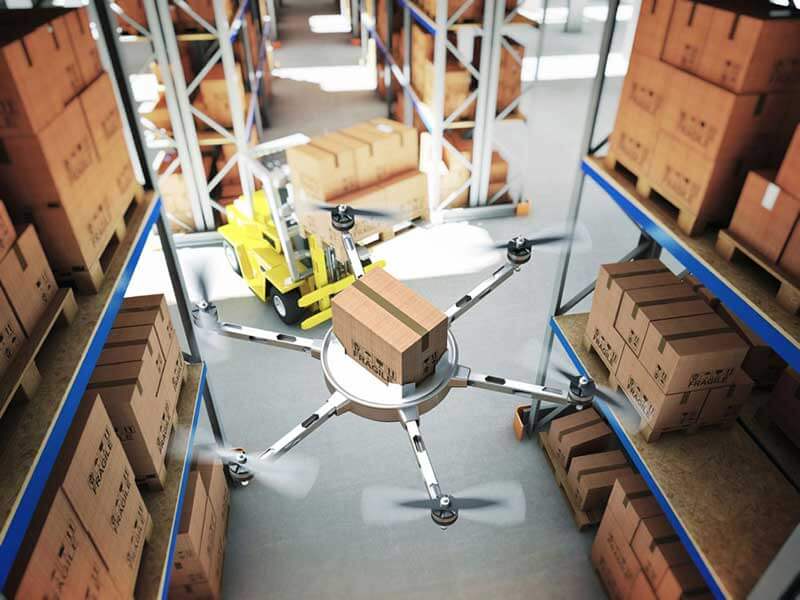- De supply chain en logistics maken een enorme transformatie door
- Logistics is uitgegroeid tot een zeer complex systeem van mensen, technologieën en processen
- Zij die zich niet voorbereiden op de toekomst hebben straks het nakijken
Elke paar jaar zijn we getuige van nieuwe golven van verandering en disruptie, wat voor vele sectoren in het bedrijfsleven gevolgen heeft. Van de allereerste assemblagelijnen tot de geavanceerde high-tech mogelijkheden die we vandaag tot onze beschikking hebben, ook de supply chain en logistiek zijn constant aan verandering onderhevig. De nieuwste trends richten zich op slim, technologie-gedreven management, het terugdringen van operationele kosten en het optimaliseren van de efficiëntie. Van zelflerende stock-picking robots tot bezorgdrones en IoT-platforms die fabrikanten, transport, retailers en de eindgebruiker in real-time met elkaar verbinden, de supply chain van de toekomst belooft sneller, wendbaarder en volledig autonoom te zijn. Hoe goed een bedrijf de huidige en toekomstige disrupties in de supply chain en logistics weet te omarmen is uiteraard bepalend voor de toekomst van dat bedrijf.
Factoren die de volgende transformatiefase bepalen
Als je de huidige supply chain en logistiek vergelijkt met een paar jaar geleden zie je dat er ontzettend veel veranderd is. Fabrikanten verkochten aan groothandelaren of retailers. Verkopers belden of bezochten hun klanten om bestellingen op te nemen. Retailers plaatsten hun bestellingen telefonisch, per fax of via e-mail. En dan werden de bestellingen in de vrachtwagens geladen en bezorgd. Deze relatief eenvoudige supply chain werd halverwege de jaren negentig met uitsterven geconfronteerd en evolueerde vervolgens in een complex ecosysteem van mensen, technologieën en processen. Volgens de Amerikaanse Roadmap for Materials Handling & Logistics zijn onze huidige supply chain- en logisticsmodellen hetzelfde lot beschoren en in 2025 waarschijnlijk zelfs verdwenen. Er zijn verschillende factoren die de volgende fase van de transformatie aansturen. Denk aan robotica en automatisering, omnichannel en e-commerce, sensortechnologie en het IoT, big data en supply chain visibility. Sommige trends zijn al in full swing en andere bevinden zich nog in de vroege stadia van ontwikkeling. In dit artikel zullen we deze ‘disruptors’ wat uitgebreider beschrijven.
1. Robotica
De integratie van zelfrijdende systemen en draagbare computers in gecoördineerde systemen leidt tot revolutionaire veranderingen in de industrie. Onbemande vrachtschepen, autonome vrachtwagens, stock-picking robots in magazijnen en drones die boodschappen bezorgen – deze ontwikkelingen zorgen ervoor dat menselijke fouten haast niet meer voorkomen. Robotica speelt in elk deel van de supply chain een rol, van grondstofwinning tot aan ’the last mile’ – de levering aan de eindgebruiker.
Een derde van organisaties maakt al gebruik van een of meerdere robotsystemen in hun supply chains. Binnen tien jaar zal dit zich uitbreiden naar driekwart. Robotsystemen waar je je het makkelijkst een voorstelling van kunt maken zijn autonome voertuigen en drones. Drones kunnen worden ingezet in de productie, voor stock-picking, het verplaatsen van pallets, onderhoud, beveiliging en de bezorging van kleine pakketten. Twee bekende bedrijven in Amerika die al bezig zijn met het implementeren van dronetechnologie zijn Amazon en Domino’s pizza.
Dankzij robotica kunnen alle elementen in de supply chain met elkaar worden geïntegreerd. Magazijnrobots met ingebouwde sensoren kunnen de kwaliteit van de producten monitoren en hierover rechtstreeks met planningssystemen communiceren, waardoor uiteindelijk bruikbare inzichten ontstaan die waardevol zijn voor optimaal supply chain management. De integratie van robotsystemen met machine learning algoritmen kan procesautomatisering veel (kosten)efficiënter maken. Hoe snel geavanceerde robotisering omarmd wordt hangt af van de resulterende winst, maar ook van de publieke perceptie. Het belangrijkste doel is echter het verbeteren van de efficiëntie en het minimaliseren van menselijke fouten.
Na de overname van Kiva Systems heeft Amazon de systemen direct in een aantal van hun magazijnen geïmplementeerd, waardoor de efficiëntie aanzienlijk is verbeterd en er meer winst gemaakt wordt. De systemen bestaan uit robots die dozen en pallets in de magazijnen autonoom kunnen verplaatsen. En het zijn niet alleen de grote bedrijven die met robotica aan de slag zijn gegaan. Zelfs kleine en middelgrote organisaties hebben robots als de relatief goedkope Baxter ‘in dienst’. Deze machines kunnen duizenden uren lang doorwerken zonder te stoppen. Dit is met menselijke werknemers ten eerste niet mogelijk én zo’n kracht zou onbetaalbaar zijn.
Met slimme en zuinige zelfrijdende vrachtwagens kunnen goederen sneller, veiliger en efficiënter vervoerd worden. De kosten hiervan liggen, vergeleken met de huidige, traditionele vrachtwagens en personeelskosten voor chauffeurs, vele malen lager. Daimler heeft bekendgemaakt in de komende tien jaar volledig geautomatiseerde vrachtwagens op de weg te hebben.

2. Omnichannel en e-commerce
93 procent van de omzet in retail wordt momenteel nog door fysieke winkels gegenereerd. Over vijf jaar zal dit naar verwachting nog maar 81 procent zijn. Onderzoeken hebben aangetoond dat omnichannel een opbouwend en versterkend effect kan hebben op de omzet. Klanten die bij een bedrijf zowel online als in de fysieke winkel kopen, besteden twee keer zoveel als klanten die alleen in een winkel kopen.
Veel fabrikanten, distributeurs, retailers en online handelaren zitten nog vast in oude processen. Maar consumenten verwachten tegenwoordig dat ze via verschillende kanalen kunnen kijken, kopen en ruilen of retourneren. Om aan de verwachtingen van de klant te kunnen voldoen – zoals via meerdere kanalen direct leveren – moeten producten met veel hogere snelheid door die supply chain en moet de leverancier de klant thuis direct kunnen bereiken. Hiervoor is niet alleen real-time inzicht in de supply chain nodig, maar ook in het gedrag van de klant. Met name hoe hij van het ene verkoopkanaal naar het andere navigeert. Hiervoor zijn aanzienlijke organisatorische veranderingen nodig op het gebied van het reactievermogen van de supply chain waarin ook krachtige data-analysemogelijkheden opgenomen moeten worden.
3. Sensoren en het Internet of Things
Het Internet of Things draait op ingebedde sensoren die in real-time en zonder enige menselijke tussenkomst met elkaar communiceren. Het IoT en sensortechnologie spelen in de toekomst een steeds crucialere rol in de transformatie van de logistieke sector. Onderzoeken hebben aangetoond dat processen als inkoop, orderverwerking, transport, productieplanning, voorraadbeheer en klantenservice nu al sterk afhankelijk zijn van sensoren en internettoepassingen. In de productie-industrie kunnen sensoren problemen ter plaatse opsporen en instructies geven om deze te corrigeren.
In de transportsector kunnen sensoren in pakketten en transportvervoerders ingebouwd worden. Zo kunnen goederen via GPS gecheckt en gevolgd worden, waardoor routering en bezorgingsprocessen efficiënter worden. Sensoren in voertuigen leveren grote hoeveelheden informatie over bijvoorbeeld temperatuur, snelheid, trilling, vloeistofniveaus, slijtagefactoren en toleranties. Hiermee wordt de conditie van het voertuig gemonitord en kan men eventuele problemen voorkomen of op tijd verhelpen om stilstandtijd zoveel mogelijk te minimaliseren. Kortom, sensortechnologie en het Internet of Things stellen organisaties in staat om de efficiëntie van hun vrachtwagens, schepen, vliegtuigen en drones te monitoren en optimaliseren en daardoor onderhouds- en operationele kosten te verlagen.
4. Big data
Organisaties genereren en verzamelen allerlei informatie over operaties, klanten, verkoop en meer. Deze gegevens komen uit bronnen als bedrijfssystemen, bestellingen, transport, logistiek, weblogs voor klanten, koopgedrag, mobiele apparaten, GPS, sensoren en sociale kanalen. Voor het beheren, analyseren en visualiseren van deze duizelingwekkende hoeveelheden data zijn echter geavanceerde algoritmen en rekenkracht nodig. Door deze gegevens begrijpelijk en daardoor bruikbaar te maken kunnen bedrijven hun klantenservice verbeteren, hun marketingoperaties efficiënter maken en zelfs predictive analytics genereren om risico’s te beperken en zich voor te bereiden op toekomstige scenario’s. Organisaties die de infrastructuren hebben om de gegevens van de supply chain te verzamelen en te analyseren en deze informatie op de juiste manier weten te gebruiken, kunnen hun voorraden, capaciteit en prijsstellingen in real-time aanpassen en snel beslissingen nemen, zonder eventuele zakelijke kansen mis te lopen. Big data stelt hen in staat om de logistiek te optimaliseren, wat resulteert in kostenbesparingen, snellere time-to-market en een kleinere ecologische voetafdruk.
5. Digitale netwerken en volledige zichtbaarheid van de supply chain
Dankzij digitale netwerken en location-based services – mogelijk gemaakt door het Internet of Things, GPS en big data – kan iedereen in de supply chain alle zendingen in real-time volgen, of het nu de fabrikant, de leverancier, transporteur of klant is. Zendingen zijn zichtbaar vanaf het moment dat de order wordt geplaatst totdat het product op de plaats van bestemming aankomt. Digitale netwerken zorgen er ook voor dat alle partijen in de supply chain eventuele problemen onmiddellijk kunnen identificeren en oplossen. Ook is het dankzij deze netwerken mogelijk om een toename in de vraag van een product direct aan alle betrokken partijen kenbaar te maken, zodat alle belanghebbenden direct actie kunnen ondernemen door bijvoorbeeld het aanbod te verhogen of de levering te versnellen. Een ander voordeel van een digitaal netwerk is dat je processen als bestellen, factureren en het afhandelen van financiële transacties tussen de deelnemers van de supply chain kunt automatiseren, transacties sneller kunt laten verlopen, het aantal fouten kunt verminderen en de efficiëntie van de gehele supply chain kunt verbeteren.
Bereid je voor op de uitdagingen van de komende tien jaar
De huidige supply chain ondergaat momenteel een belangrijke transformatie en is in de nabije toekomst naar verwacht volledig self-managed. Het ongekend snelle tempo van de veranderingen wordt aangevoerd door de top vijf ‘disruptors’ die we in dit artikel hebben besproken. Bedrijven die deze radicale technologieën omarmen en toepassen zullen beter voorbereid zijn op de uitdagingen van de komende tien jaar en daar de vruchten van plukken. Het is niet langer voldoende om alleen maar te investeren in human resources, technologie en infrastructuur. Het omarmen, absorberen en toepassen van deze ‘disruptors’ zal niet gemakkelijk zijn, maar zij die zich niet voorbereiden op deze toekomst hebben straks hoogstwaarschijnlijk het nakijken.
Share via:


